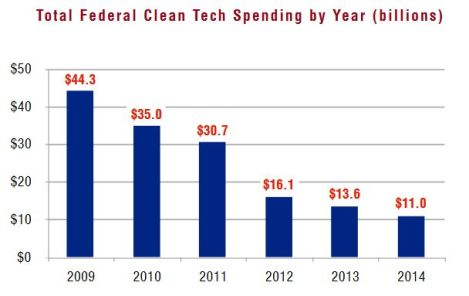If you care about cleantech in the U.S., this graph should make your blood run cold:
That’s from a new report — “Beyond Boom and Bust: Putting Clean Tech on a Path to Subsidy Independence” — from folks at the Breakthrough Institute, Brookings Institution, and World Resources Institute. It’s a welcome and much-needed attempt to put some numbers behind the debate over federal cleantech support.
It’s divided into three parts. The first tells the story of cleantech policy over the last five years. Early in his term, Obama unleashed a ton of support for cleantech, mainly via the stimulus bill, but also by funding some programs from the Bush era and earlier. At around $150 billion, federal cleantech spending from 2009-2014 will amount to over three times what was spent from 2002-2008. But that funding is dropping off a cliff:
In the absence of legislative action to extend or replace current subsidies, America’s clean tech policy system will have been largely dismantled by the end of 2014, a casualty of the scheduled expiration of 70 percent of all federal clean tech policies. … Furthermore, many of the remaining programs will end shortly after 2014.
Yikes.
Part two of the report details the expected effects of this drop-off in funding, sector by sector. Things will be particularly bad for wind and solar, which are competing directly with historically low natural-gas prices.
Part three is the most interesting, to me anyway. The premise is that the coming evaporation of U.S. cleantech support is a good occasion for rethinking how that support works and how to do it better. Consequently, the report makes several recommendations for better cleantech subsidies.
I have a bit to say about the recommendations, but it’s worth pausing to ask whether the premise is actually true. This is, after all, a rather delicate political moment. Cleantech support is fighting for survival. Is that really the best time to rethink it? Bad-mouthing the very policies under assault runs the risk of empowering their opponents. And it’s abundantly clear that those opponents do not have better subsidies in mind. They are a demolition crew. Whatever else you can say about the patchwork of support the U.S. has for clean energy now, it’s a damn sight better than nothing.
But whatever. The political process in this country is so broken there’s no margin in trying to finesse it. Might as well have reasonable conversations on the side!
Anyway, no sense pretending: U.S. cleantech policy is an incoherent mess. Above all, it is inconsistent and unreliable, riddled with programs that are renewed (or not) every few years. That is not a recipe for attracting stable private capital. Also, U.S. policy funnels far too much support through the tax code, an opaque and ineffective mechanism that encourages crony capitalism.
Most folks agree with those critiques. But the report’s authors have bigger axes to grind. Here’s a graph showing where support has been going under Obama:
Basically, Obama dumped a ton of money into deploying large amounts of clean energy and creating markets for batteries and biofuels. I actually think this makes a good amount of political sense — deployment creates invested constituencies, which is what cleantech needs more than anything right now — but over the long term, the authors say that this state of affairs can’t, or at least shouldn’t, continue.
One problem is that many deployment subsidies pay a flat per-megawatt-hour rate for new renewables. This encourages large-scale deployment of the cheapest, best-established cleantech, but it doesn’t encourage innovation or support cutting-edge new market entrants.
The report’s ideal subsidies would:
- explicitly incentivize innovation and cost cutting
- not “choose winners” a priori, but be allocated based on objective, transparent criteria
- phase out based on set metrics of market maturity or cost
- be tailored to technologies at different stages of development
- minimize transaction costs
- be long-term
The recommendations in the report are more detailed. Check them out.
I basically agree with all of the recommendations. We really do need to think consciously and holistically about the entire pipeline of technology development, from the lab, across the “valley of death,” to maturity and scale. The crude tools we are now using don’t do that, at all.
Still, on climate and clean energy, I’m a both/and guy. I agree we need new, smarter subsidies and some coherent innovation policy. But I also think we need massive, immediate deployment of the clean energy we’ve got. (That brute-force deployment has, it should be noted, done a pretty damn good job driving down costs.)
The argument to be made about cleantech subsidies is not just about quality, but quantity. We need more, much more, of all kinds. No liberal should accept the bullsh*t talking point that an “age of austerity” is inevitable or unavoidable. Austerity is a choice, and a bad one at that. Pushing for smart government policy is never going to succeed if we accept perpetually shrinking spending as a fact of life.





